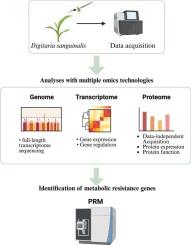组学分析揭示了马地黄抗除草剂的关键基因
IF 4
1区 农林科学
Q2 BIOCHEMISTRY & MOLECULAR BIOLOGY
引用次数: 0
摘要
马地黄(L.)范围被认为是最具问题的农业杂草之一,化学控制仍然是一个关键的管理策略。然而,日益增加的选择压力导致了抗性种群的出现,这些种群繁殖并形成优势群落,从而严重危害了作物产量。揭示血根草的抗性机制尤为重要,而杂草组织学资源的缺乏一直是研究血根草抗性机制的障碍,如今,随着组织学技术的发展,多组学联合应用于杂草抗性基因鉴定的方法越来越完善。在我们前期的研究中,我们已经初步论证了血血草对ALS抑制剂的抗性与P450酶活性的升高有关。在这里,我们采用单分子实时(SMRT)测序技术获得血马尾草的全长转录本。利用DIA蛋白质组学,我们鉴定出了上调的除草剂代谢蛋白,并通过PRM分析进行了验证。通过整合转录组学和蛋白质组学结果,我们鉴定出CYP709B2和CYP74B2是介导血根耐药的关键效应基因。本研究阐明了血血草的抗性模式和相关基因,丰富了血血草的生物信息学资源,为抗除草剂杂草的管理提供了基础。本文章由计算机程序翻译,如有差异,请以英文原文为准。

Omics analysis reveals key genes mediating herbicide resistance in Digitaria sanguinalis
Digitaria sanguinalis (L.) Scop is recognized as one of the most problematic agricultural weeds, with chemical control remaining a crucial management strategy. However, increased selection pressures have led to the emergence of resistant populations that reproduce and establish themselves as dominant communities, thereby severely jeopardizing crop yields. It is especially crucial to reveal the resistance mechanism of D.Sanguinalis, and the lack of weed histology resources has always been an obstacle to the study of resistance mechanism, nowadays, with the development of histology technology, the combination of multi-omics applied to the identification of weed resistance genes is becoming more and more perfect. In our previous study, we have preliminarily demonstrated that the resistance of D.Sanguinalis to ALS inhibitors is related to the increase of P450 enzyme activity. Here, we employed single-molecule real-time (SMRT) sequencing technology to obtain full-length transcripts of D. sanguinalis. Using DIA proteomics, we identified upregulated herbicide-metabolizing proteins, which were validated via PRM analysis. By integrating the transcriptomic and proteomic results, we identified CYP709B2 and CYP74B2 as key effector genes that mediate resistance in D. sanguinalis. We elucidated the resistance patterns and specific genes associated with D. sanguinalis, thereby enriching the bioinformatics resources available for this species and providing a foundation for herbicide-resistant weed management.
求助全文
通过发布文献求助,成功后即可免费获取论文全文。
去求助
来源期刊
CiteScore
7.00
自引率
8.50%
发文量
238
审稿时长
4.2 months
期刊介绍:
Pesticide Biochemistry and Physiology publishes original scientific articles pertaining to the mode of action of plant protection agents such as insecticides, fungicides, herbicides, and similar compounds, including nonlethal pest control agents, biosynthesis of pheromones, hormones, and plant resistance agents. Manuscripts may include a biochemical, physiological, or molecular study for an understanding of comparative toxicology or selective toxicity of both target and nontarget organisms. Particular interest will be given to studies on the molecular biology of pest control, toxicology, and pesticide resistance.
Research Areas Emphasized Include the Biochemistry and Physiology of:
• Comparative toxicity
• Mode of action
• Pathophysiology
• Plant growth regulators
• Resistance
• Other effects of pesticides on both parasites and hosts.

 求助内容:
求助内容: 应助结果提醒方式:
应助结果提醒方式:


